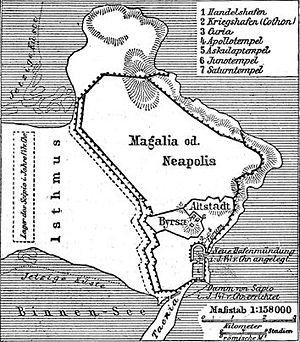Siege of Carthage
| date | 149 BC Until spring 146 BC. Chr. |
|---|---|
| place | Carthage |
| output | Roman victory |
| consequences | End of the Punic Wars as a result of the destruction of Carthage |
| Parties to the conflict | |
|---|---|
| Commander | |
|
Publius Cornelius Scipio Aemilianus Africanus |
|
| Troop strength | |
| 40,000 | 500,000 (300,000 soldiers, 450,000 civilians) |
| losses | |
|
17,000 |
250,000 dead, 50,000 enslaved |
The siege of Carthage was the final and decisive battle of the Third Punic War . The complete destruction of the city ended the existence of the Carthaginian Empire.
Starting position
After the defeat in the Second Punic War , the Carthaginians were able to rebuild their former economic size and became a dangerous enemy in the eyes of the Romans. In the Senate there were repeated critical voices against Carthage. So Cato the Elder repeated the sentence in each of his speeches to the Senate: Ceterum censeo Carthaginem esse delendam (“Besides, I am of the opinion that Carthage must be destroyed”).
The Carthaginians were allowed to use the terms of the peace treaty of 201 BC. Wage war with Rome's permission, but fell victim to spontaneous raids by the Numidian ruler Massinissa . A campaign against Massinissa that had not been announced to the Romans became the casus belli for the Third Punic War.
The siege
149 BC Around 80,000 infantry and 4,000 horsemen under Manius Manilius were brought together in Sicily to cross to Utica in North Africa. After landing in Africa, the Carthaginians complied with the Romans' demand to lay down their arms and, according to Polybius , delivered 20,000 pieces of weaponry and 2,000 catapults. The much more drastic demand to leave the city, to be allowed to resettle within a maximum of 15 km and to demolish Carthage forever, the inhabitants did not want to bow to. They hastily implemented defensive measures and posted 20,000 defenders at the entrances to the city.
The Romans then began the three years of the initially badly organized siege of the city. During this period, the Carthaginians succeeded several times in breaking out of the city, destroying siege engines and killing Roman soldiers. The approximately 500,000 residents trapped in their city also organized the establishment of a weapons production facility and sufficient supplies by sea.
After two years of unsuccessful siege, Scipio Aemilianus was on the Roman side in 147 BC. Appointed the new commander in chief of the siege army in Africa. For this, the limit for the minimum age of consuls had to be lowered. Scipio began first with raising the morale of the troops and silencing the critical voices of the soldiers, who were mostly farmers and slowly impoverished during the siege.
On the military side, too, the first successes came after Scipio's appointment. So the land army of the Carthaginians was defeated at Nepheris and with the establishment of a ten kilometer long contravallation line and a circumvallation the city could be completely enclosed on land. In addition, the besiegers erected a two meter high wall on which catapults were installed to bombard the city. An artificial mole was raised on the lake side to prevent ships from supplying the city.
Storming the city
The Carthaginians reinforced their defense on the land side, as it was from there that they awaited the decisive Roman attack. This came in the spring of 146 BC. However from the sea side. Roman troops climbed the harbor wall and were able to hold it long enough to allow a large part of the army to march into the city. The Romans fought their way over the roofs of the city to the market square and occupied it.
The Carthaginians then withdrew to the fortified district of Byrsa . This was only stormed by the Romans on the seventh day of their invasion of the city. The last 900 defenders of the district's castle fought to the point of giving up completely. The Carthaginian leader Hasdrubal fled at the last moment for fear of the revenge of the Romans, whose soldiers he had tortured before their eyes. His wife then cursed him, sacrificed his two sons and jumped with the last survivors into the fire of the burning temple of Eshum . When Scipio heard of these dramatic events, he is said to have exclaimed a sentence from Homer, alluding to the conquest of Troy :
"The day of the fall of the holy city of Troy will come, and King Priam and his warrior will fall with it"
Apparently he feared that one day Rome might be fated to Carthage.
Effects

The 50,000 surviving residents were all dragged into slavery and the city was razed to the ground. The legend that the area of Carthage was sprinkled with salt to make it sterile dates back to the 19th century and has now been refuted. However, after the end of the Third Punic War, the urban area was uninhabited for centuries.
Scipio was allowed to use the additional title Africanus in his name after the end of the battle . His adversary Hasdrubal died as a prisoner in Italy.
literature
- Heinz Bellen : Metus Gallicus - Metus Punicus. On the fear motive in the Roman Republic . Stuttgart 1985.
- Matthias Gelzer : Nasica's opposition to the destruction of Carthage . In: Philologus 86 (1931), pp. 261-299.
- O. Hansen: The Third Roman-Carthaginian War. The destruction of Carthage in 146 BC Chr. Saarbrücken 2008.
- Wilhelm Hoffmann : The Roman politics of the 2nd century and the end of Carthage . In: Historia 9 (1960), pp. 309-344. Reprinted in: Richard Klein (Ed.): The state thinking of the Romans . Darmstadt 1966, pp. 178-230.
- Karl-Wilhelm Welwei : On the Metus Punicus in Rome around 150 BC. Chr. In: Hermes 117 (1989), pp. 314-320.
